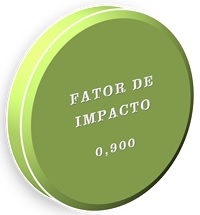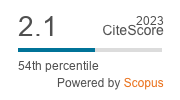Root growth and dry mass production in orange sweet potato under phosphorus doses
DOI:
https://doi.org/10.1590/1983-21252025v3812869rcKeywords:
Ipomoea batatas. Commercial roots. Growing seasons. Fertilization.Abstract
Sweet potato is a root of great global importance in nutrition. Therefore, it is crucial to evaluate its aerial part production and root growth, especially with the application of phosphorus (P). This nutrient is essential for many plants, promoting root growth and energy production (ATP). Thus, this study aims to evaluate root growth and dry matter production in sweet potato under phosphorus fertilization and at two planting times (S1 and S2). The study was conducted in an experimental area of the Universidade Federal Rural do Semi-Árido (UFERSA), Mossoró, RN, Brazil. The experimental design was randomized blocks with four replicates. The treatments consisted of P doses (0, 60, 120, 180, and 240 kg ha-1 of P2O5). At 153 days after planting, the dry mass of the aerial part (APDM) and commercial roots (DMCR), aerial part dry mass production (APDMP), the harvest index (HI), classification, and length (LCR), diameter (DCR), and shape (SCR) of the commercial roots were evaluated. The 60 kg ha-1 dose of P2O5 promoted the highest number of commercial roots, mainly for S2, and the predominance of roots with the same shape in both growing seasons for the same dose. The DMCR and HI were higher in S2, essentially for the 120 kg ha-1 dose of P2O5. Dry mass production was higher for S1, showing a strong correlation, with the 60 kg ha-1 dose of P2O5 standing out.
Downloads
References
ABBASIAN, et al. Effect of various phosphorus and calcium concentrations on potato seed tuber production. Journal of Plant Nutrition, 41: 1765-1777, 2018.
ALAM, et al. Minerals, vitamin C, and effect of thermal processing on carotenoids composition in nine varieties orange-fleshed sweet potato (Ipomoea batatas L.). Journal of Food Composition and Analysis, 92: 103582, 2020.
ALVARES, et al. Köppen’s climate classification map for Brazil. Meteorologische Zeitschrift, 22: 711-728, 2013.
AZEVEDO, A. M. et al. Desempenho agronômico e parâmetros genéticos em genótipos de batata-doce. Horticultura Brasileira, 33: 84-90, 2015.
BORU, M.; KEBEDE, T. W.; TANA, T. Effects of application of farmyard manure and inorganic phosphorus on tuberous root yield and yield related traits of sweet potato [Ipomoea batatas (L.) Lam] at Assosa, Western Ethiopia. Advances in Crop Science and Technology, 5: 1000302, 2017.
CLIMATE-DATA.ORG. Clima. 2021. Available at: <https://pt.climate-data.org/america-do-sul/brasil/rio-grande-do-norte/mossoro-4448/>. Access on: Jun. 15, 2023.
COELHO, R. S. et al. Variação da produção de raízes e desenvolvimento da parte aérea de batata-doce em função da época de colheita. Agri-Environmental Sciences, 8: 1-10, 2022.
DING, Y. et al. Mechanism of low phosphorus inducing the main root lengthening of rice. Journal of Plant Growth Regulation, 40: 1032-1043, 2021.
DONATO, L. M. S. et al. Uso de ramas de batata-doce para produção de feno. Ciência Animal Brasileira, 21: e-53493, 2020.
EMBRAPA - Empresa Brasileira de Pesquisa Agropecuária. 2008. Cultura da batata-doce. Sistemas de produção, versão eletrônica. Available at: . Access on: Jun. 1, 2022.
EMBRAPA - Empresa Brasileira de Pesquisa Agropecuária. Sistema de produção de batata-doce. Embrapa Hortaliças, sistema de produção, 9, 2021. ISSN 1678-880X, versão eletrônica. Available at: <https://www.embrapa.br/web/portal/hortalicas/como-plantar-batata-doce>. Access on: Jun. 1, 2022.
FERREIRA, D. F. Sisvar: a Guide for its Bootstrap procedures in multiple comparisons. Ciência e Agrotecnologia, 38: 109-112, 2014.
GOMES, R. V.; SILVA, A. D. A.; COUTINHO, G. V. Batata-doce. CAVALCANTI, F. J. A. et al. (Eds). Recomendações de adubação para o estado de Pernambuco: 2ª aproximação. Recife, PE: Instituto Agronômico de Pernambuco - IPA. 2008, 3ª. ed. Revisada, cap. 9, p. 125.
HOSSAIN, M. M. et al. Evaluation of the growth, storage root yield, proximate composition, and mineral content of colored sweet potato genotypes. Journal of Agriculture and Food Research, 8: 100289, 2022.
HUAMÁN, Z. Botánica sistemática y morfologia de la planta de batata o camote. Lima, Perú: Centro Internacional de la Papa, 1992. 22 p. (Boletín de Información Técnica, 25).
LI, C.; WANG, J.; ZHANG, Y. C. Root growth and phosphorus efficiency among sweet potato genotypes under low phosphorus. Journal of Plant Nutrition, 43: 1320-1330, 2020.
LIU, M. et al. Effect of phosphorus application on economic yield, quality and phosphorus utilisation efficiency of purple-fleshed sweetpotato. Plant, Soil & Environment, 68: 451-458, 2022.
MINEMBA, D. et al. Variation in morphological and physiological root traits and organic acid exudation of three sweet potato (Ipomoea batatas) cultivars under seven phosphorus levels. Scientia Horticulturae, 256: 108572, 2019.
MUSTACISA-LACABA, M.; TAN, N.; VILLANUEVA, R. The Effect of eliminating the application of phosphorus-containing fertilizer for the bulking period of sweet potato (Ipomoea batatas) production. ASEAN Journal of Scientific and Technological Reports, 26: 58-66, 2023.
OMONDI, J. O. et al. Phosphorus affects storage root yield of cassava through root numbers. Journal of Plant Nutrition, 42: 2070-2079, 2019.
QUEIROGA, R. C. F. et al. Fisiologia e produção de cultivares de batata-doce em função da época de colheita. Horticultura Brasileira, 25: 371-374, 2007.
RAHAJENG, W. et al. Evaluation of Promising Sweet potato Clones for Higher Root Yield and Dry Matter Content. Planta Tropika, 9: 42-47, 2021.
RÓS, A. B. Produtividade e formato de raízes tuberosas de batata-doce em função do número de gemas enterradas. Científica, 45: 253-256, 2017.
SANTOS, A. R. et al. Produtividade de clones de batata doce em função de doses de nitrogênio. Horticultura Brasileira, 35: 445-452, 2017.
SHUKLA, D.; RINEHART, C. A.; SAHI, S. V. Comprehensive study of excess phosphate response reveals ethylene mediated signaling that negatively regulates plant growth and development. Scientific Reports, 7: 3074, 2017.
SILVA, J. et al. Características de raízes tuberosas de clones de batata-doce por meio de técnicas multivariadas para seleção de genótipos superiores. Revista Verde de Agroecologia e Desenvolvimento Sustentável, 13: 33-38, 2018.
SILVEIRA, F. P. M. et al. Agronomic performance of cassava fertilized with phosphorus doses. Bioscience Journal, 39: e39077, 2023.
VILLORDON, A.; GREGORIE, J. C.; LABONTE, D. Direct measurement of sweetpotato surface area and volume using a low-cost 3D scanner for identification of shape features related to processing product recovery. HortScience, 55: 722-728, 2020.
YU, X.; KEITEL, C.; DIJKSTRA, F. A. Global analysis of phosphorus fertilizer use efficiency in cereal crops. Global Food Security, 29: 100545, 2021.
ZHAO, X. et al. Response of growth characteristics and endogenous hormones of Sophora davidii to low-phosphorus stress. Acta Physiologiae Plantarum, 43: 1-14, 2021.
Downloads
Published
Issue
Section
License
Os Autores que publicam na Revista Caatinga concordam com os seguintes termos:
a) Os Autores mantêm os direitos autorais e concedem à revista o direito de primeira publicação, com o trabalho simultaneamente licenciado sob a Licença Creative Commons do tipo atribuição CC-BY, para todo o conteúdo do periódico, exceto onde estiver identificado, que permite o compartilhamento do trabalho com reconhecimento da autoria e publicação inicial nesta revista, sem fins comerciais.
b) Os Autores têm autorização para distribuição não-exclusiva da versão do trabalho publicada nesta revista (ex.: publicar em repositório institucional ou como capítulo de livro), com reconhecimento de autoria e publicação inicial nesta revista.
c) Os Autores têm permissão e são estimulados a publicar e distribuir seu trabalho online (ex.: em repositórios institucionais ou na sua página pessoal) a qualquer ponto antes ou durante o processo editorial, já que isso pode gerar alterações produtivas, bem como aumentar o impacto e a citação do trabalho publicado (Veja O Efeito do Acesso Livre).







